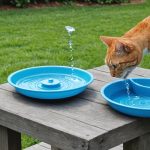Understanding Cats’ Hydration Needs
Ensuring proper hydration is crucial for maintaining your cat’s overall well-being. Cats often have low thirst drives, which may result in them drinking less water than necessary for their health. Understanding their water preferences and habits can aid in promoting better hydration.
Cats are naturally drawn to running water. In the wild, felines instinctively choose fresh, moving water over stagnant sources due to reduced contamination risk. At home, you might notice your cat prefers drinking from a faucet or pet fountain, which mimics natural water flow. Incorporating such hydration tips into their environment can encourage increased water intake.
Cela peut vous intéresser : Crafting the Perfect Balanced Diet for Cats with Liver Disease: Tailoring Nutrition to Meet Their Unique Needs
Detecting signs of dehydration in cats is vital for timely intervention. Common indicators include dry mouth, lethargy, sunken eyes, or reduced skin elasticity. Hydrated cats tend to exhibit shiny fur, moist gums, and normal skin elasticity, contributing to their vibrant appearance and active lifestyle. Noting these signs can help in maintaining a cat’s health by ensuring they consume enough water daily.
Ensuring your cat has access to clean, appealing water sources and tracking their hydration can significantly enhance their quality of life. Encouraging healthy water-drinking habits is integral to promoting their longevity and vitality.
Lire également : Spotting and Treating Cat Mange: A Comprehensive Guide for Pet Owners
Choosing the Right Water Fountain
Selecting the best cat water fountains involves evaluating several key factors. First, consider the available space where the fountain will be placed. You want to ensure it fits comfortably without being obtrusive. Next, focus on your pet’s preferences. Some cats prefer bubbling water, while others favour a free-flowing stream.
Understanding the features of cat fountains is crucial. Look for fountains with adjustable flow settings to cater to your cat’s needs. Many models also offer quiet motors, which can be beneficial if your cat is easily startled by noise. Additionally, think about the material. Stainless steel or ceramic options are often more hygienic than plastic.
Several models stand out for their reliable design and functionality. These popular options often include sophisticated filtration systems, which play a vital role in maintaining water quality. Effective filters can remove impurities and ensure that the water your cat drinks remains clean and safe.
Consider these factors and features when making your water fountain selection. Prioritising these aspects will help ensure your cat stays well-hydrated, offering an optimal balance of convenience and care.
Setting Up the Hydration Station
When designing a hydration station setup for your feline friend, consider location as paramount. Placing your cat’s fountain in a low-traffic area enhances comfort and encourages your furry companion to drink more regularly. Avoid loud machines or bustling corridors to provide a serene drinking environment.
Incorporating the fountain into your home decor can be both functional and stylish. Try using natural materials like bamboo or wood to blend the cat water station with your home’s aesthetic. Additionally, placing the fountain on a decorative mat helps maintain cleanliness and can enhance the visual appeal.
Make sure the station is easily accessible to your cat. Position it at a height that doesn’t force your feline to stretch or stoop awkwardly. Your cat should be able to approach and drink from the fountain without any hurdles. Placing multiple hydration stations around your home further ensures accessibility and prevents territorial disputes if you have more than one pet.
For the best placement of cat fountains, consider areas where your cat often spends time. This encourages regular hydration and helps you monitor their water intake more effectively.
Maintaining the Hydration Station
Ensuring a clean cat water fountain is vital for your pet’s health. Regular water fountain maintenance helps keep the water fresh and appealing for your feline friend. Begin by placing the fountain in a designated spot and routinely cleaning it. Ideally, you should clean the fountain at least once a week; more often if you have multiple cats.
Dismantle the device and clean each part, paying special attention to filters. Filters should be replaced according to the manufacturer’s instructions or when they appear dirty. Regularly replacing filters helps in keeping the water fresh by trapping hair and debris.
Another crucial factor is changing the water itself. It’s advisable to replenish water at least once daily, ensuring it’s free from any odour or bacteria build-up.
Troubleshooting potential issues is also a part of effective maintenance. If your fountain’s water isn’t flowing smoothly, check for clogging in the pump. Ensure all parts are correctly placed to avoid malfunctions. A comprehensive water fountain maintenance routine ensures your cat stays hydrated with clean and fresh water at all times. Making these tasks a habit contributes immensely to your cat’s overall wellbeing.
Benefits of Running Water for Cats
Running water holds numerous benefits for feline hydration and overall health. As natural explorers, cats are instinctively attracted to moving water, which can significantly encourage them to drink more. This innate fascination stems from wild ancestors relying on rivers and streams as primary water sources, deeming them cleaner and safer than stagnant pools.
Impact on Feline Behaviour and Health
The act of drinking more due to the presence of running water can lead to various cat hydration benefits. Adequate hydration supports better kidney function and reduced risk of urinary tract issues, a common feline health concern. Moreover, increased water intake helps maintain a healthy weight by promoting better digestion and metabolism.
Stationary vs. Running Water Sources
When comparing stationary bowls to running water sources like fountains, the latter clearly offers superior hydration opportunities for pets. Stationary sources can deter cats, as water may quickly become stale or contaminated. In contrast, running water often remains fresh and oxygenated, making it more appealing and healthier. Cats who previously shy away from their bowls might find fountains inviting, significantly boosting their daily water consumption. Ultimately, choosing a water source that draws your pet is crucial in ensuring they stay hydrated and healthy.
Creative Enhancements for the Hydration Station
A cat’s water fountain can be more than just a functional device; it can also serve as an artistic centrepiece in your home. Incorporating fun ideas to personalize the hydration station not only makes it an attractive home decor piece but can also stimulate your feline’s interest. Consider decorating it with playful themes that match your home style, like using colourful pebbles or charming decals.
Bringing nature inside is another excellent way to enhance your cat water fountain. By adding plant life around the station, you create a more inviting environment. Choose pet-safe plants, like spider plants or Boston ferns, to accompany and naturally complement the fountain’s presence.
Lighting plays a crucial role in creating an appealing water oasis. Soft LED lights can illuminate the water fountain, making it visually engaging for your cat. Coloured lights can add a whimsical or serene ambiance that captivates both pets and humans.
Take advantage of these creative cat fountain ideas to transform a utilitarian object into a delightful feature. By utilizing lighting and colours, and incorporating natural elements, you set the stage for a hydration station that’s as charming as it is essential.











